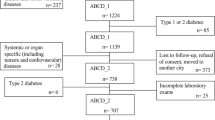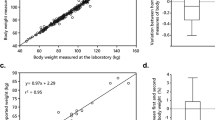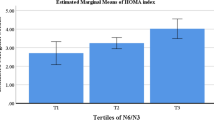Abstract
OBJECTIVE: To evaluate whether postprandial abnormalities of energy expenditure and/or lipid oxidation are present in healthy, normal-weight subjects with a strong family history of obesity and thus at high risk to become obese.
DESIGN: Case–control study.
SUBJECTS: A total of 16 young healthy men participated in the study. Eight subjects had both parents overweight (father's and mother's body mass index (BMI) >25 kg/m2) and eight had both parents with normal body weight (father's and mother's BMI<25 kg/m2, respectively). The group of subjects with overweight parents was similar to that with normal-weight parents (control group) in terms of BMI (23.7±1.7 vs 22.7±1.1 kg/m2) (M±s.d.) and fat-free body mass (FFM) (60.5±4.9 vs 58.4±2.0 kg), but was slightly older than the control group (25.4±3.3 vs 22.7±2.4 y; P<0.05).
MEASUREMENTS: Energy expenditure (EE) was measured by indirect calorimetry, and blood samples were taken for the evaluation of metabolic variables in the fasting state and every hour for 8 h after a standard fat-rich meal (protein 15%, carbohydrate 34%, fat 51%, 4090 kJ).
RESULTS: Fasting plasma glucose, cholesterol, HDL-cholesterol, triglyceride, free fatty acid (FFA) and leptin concentrations were similar in both groups of participants, but subjects with overweight parents has significantly lower plasma insulin concentrations (5.11±0.51 vs 7.07±1.56 μU/ml; P<0.007) and HOMA index of insulin resistance (1.1±0.1 vs 1.6±0.4; P<0.01). Postprandial plasma glucose, triglyceride, FFA and leptin concentrations were similar in the two groups, whereas insulin levels were significantly lower in the group with both parents overweight at 3, 5, 6, 7 and 8 h. Fasting and postprandial EE, and fasting lipid and carbohydrate oxidation were similar in both groups. On the contrary, postprandial carbohydrate oxidation (incremental area under curve) was significantly higher (196.25±94.75 vs 75.88±74.72 mg/kg FFM × 8 h; P<0.007) and that of lipid oxidation lower (90.93±80.32 vs 163.68±108.22 mg/kg FFM × 8 h; P<0.05) in the group of subjects with overweight parents.
CONCLUSION: Normal-weight subjects with a strong family history of obesity present a reduced lipid oxidation in the postprandial period and a metabolic profile characterized by low plasma insulin levels and the HOMA index, which is compatible with increased insulin sensitivity. These metabolic characteristics may be considered as early predictors of weight gain and are probably genetically determined.
This is a preview of subscription content, access via your institution
Access options
Subscribe to this journal
Receive 12 print issues and online access
$259.00 per year
only $21.58 per issue
Buy this article
- Purchase on Springer Link
- Instant access to full article PDF
Prices may be subject to local taxes which are calculated during checkout



Similar content being viewed by others
References
WHO Consultation in Obesity. Global prevalence and secular trends in obesity. In: World Health Organisation (eds). Obesity preventing and managing the global epidemic. WHO: Geneva; 1998. pp 17–40.
The ILSI Europe Overweight and Obesity in Children Task Force. Overweight and obesity in european children and adolescents. Causes and consequences—prevention and treatment. A Report. The ILSI Europe Overweight and Obesity in Children Task Force ILSI Europe, Brussels; 2000.
Gordon T, Kannel WB . Obesity and cardiovascular disease: the Framingham Study. J Clin Endocrinol Metab 1976; 5: 367–375.
Chan JM, Rimm EB, Coldiz GA, Stampfer MJ, Willett WC . Obesity, fat distribution and weight gain as risk factors for clinical diabetes in men. Diabetes Care 1994; 17: 961–969.
Weinsier RL, Hunter GR, Heini AF, Goran MI, Sell SM . The etiology of obesity: relative contribution of metabolic factors, diet, and physical activity. Am J Med 1998; 105: 145–150.
Ravussin E, Bogardus C . Energy balance and weight regulation: genetics versus environment. Br J Nutr 2000; 83: S17–S20.
Comuzzie A, Allison D . The search for human obesity genes. Science 1998; 280: 1374–1377.
Bouchard C, Rice T, Lemieux S, Despés P-J, Perusse L, Rao DC . Major gene for abdominal visceral fat area in Quebec Family Study. Int J Obes Relat Metab Dosord 1996; 20: 420–427.
Stunkard AJ, Harris JR, Pedersen NL, McClearn GE . The body-mass index of twins who have been reared apart. N Engl J Med 1990; 322: 1483–1487.
Katzmarzyk PT, Pérusse L, Tremblay A, Bouchard C . No association between resting metabolic rate or respiratory exchange ratio and subsequent changes in body mass and fatness: 5 1/2 year follow-up of the Québec Family Study. Eur J Clin Nutr 2000; 54: 610–614.
Tucker LA, Kano MJ . Dietary fat and body fat: a multivariate study of 205 adult females. Am J Clin Nutr 1992; 56: 616–622.
Astrup A, Buemann B, Christensen NJ, Toubro S . Failure to increase lipid oxidation in response to increasing dietary fat content in formerly obese women. Am J Physiol 1994; 266: E592–E599.
Zurlo F, Lillioja S, Esposito-Del Puente A, Nyomba BL, Raz I, Saad MF, Swinburn BA, Knowler WC, Bogardus C, Ravussin E . Low ratio of fat to carbohydrate oxidation as predictor of weight gain: study of 24 h RQ. Am J Physiol 1990; 259: E650–E657.
Froidevaux F, Schutz Y, Christin L, Jéquier E . Energy expenditure in obese women before and during weight loss, after refeeding and in the weight-relapse period. Am J Clin Nutr 1993; 57: 35–42.
Whitaker R, Wright JA, Pepe MS, Seidel KD, Dietz WH . Predicting obesity in young adulthood from childhood and parental obesity. N Engl J Med 1997; 337: 869–873.
Istituto Nazionale di Ricerca per gli Alimenti e la Nutrizione. Tabelle di composizione degli alimenti. EDRA Medical Publishing & New Media, Milan, Italy; 2000.
Annuzzi G, Vaccaro O, Caprio S, Di Bonito P, Caso P, Riccardi G, Rivellese A . Association between low habitual physical activity and impaired glucose tolerance. Clin Physiol 1985; 5: 63–70.
Jones PJH, Ridgen JE, Phang PT, Birmingham CL . Influence of dietary fat polyunsaturated to saturated ratio on energy substrate utilization in obesity. Metabolism 1992; 41: 396–401.
Weir JbdeV . New methods for calculating metabolic rate with special reference to protein metabolism. J Physiol 1949; 109: 1–9.
Kotler DP, Burastero S, Wang J, Pierson Jr RN . Prediction of body cell mass, fat-free mass, and total body water with bioelectrical impedance analysis: effects of race, sex, and disease. Am J Clin Nutr 1996; 64: 489S–497S.
Lukaski HC, Bolonchuk WW, Hall CB, Siders WA . Validation of tetrapolar bioelectrical impedance method to assess human body composition. J Appl Physiol 1986; 60: 1327–1332.
Ma Z, Gingerich RL, Santiago JV, Klein S, Smith CH, Landt M . Radioimmunoassay of leptin in human plasma. Clin Chem 1996; 42: 942–946.
Matthews DR, Hosker JP, Rudenski AS, Naylor BA, Treacher DF, Turner RC . Homeostasis model assessment: insulin-resistance and B-cell function from fasting plasma glucose and insulin concentrations in man. Diabetologia 1985; 28: 412–419.
Seidell JC, Muller DC, Sorkin JD, Andres R . Fasting respiratory exchange ratio and resting matabolic rate as predictor of weight gain: the Baltimore Longitudinal Study of Aging. Int J Obes Relat Metab Disord 1992; 16: 667–674.
Norman RA, Tataranni PA, Pratley R, Thompson DB, Hanson RL, Prochazca M, Baier L, Ehm MG, Sakul H, Foroud T, Garvey WT, Burns D, Knowler WC, Bennett PH, Bogardus C, Ravussin E . Autosomal genomic scan for loci linked to obesity and energy metabolism in Pima Indians. Am J Hum Genet 1998; 62: 659–668.
Swinburn BA, Nyomba BL, Saad MF, Zurlo F, Raz I, Knowler WC, Lillioja S, Bogardus C, Ravussin E . Insulin resistance associated with lower rates of weight gain in Pima Indians. J Clin Invest 1991; 88: 168–173.
Valdez R, Mitchell BD, Haffner SM, Hazuda HP, Morales PA, Monterosa A, Stern MP . Predictors of weight change in bi-ethnic population: the San Antonio Heart Study. Int J Obes Relat Metab Disord 1994; 18: 85–91.
Hoag S, Marshall JA, Jones RH, Hamman RF . High fasting insulin levels associated with lower rates of weight gain in persons with normal glucose tolerance: the San Luis Valley Diabetes Study. Int J Obes Relat Metab Disord 1995; 19: 175–180.
Caro JF, Sinha MK, Kolaczynski JW, Zhang PL, Considene RV . Leptin: the tale of an obesity gene. Diabetes 1997; 45: 1455–1462.
Ravussin E, Pratley RE, Maffei M, Wang H, Friedman JM, Bennet PH, Bogardus C . Relatively low plasma leptin concentrations precede weight gain in Pima Indians. Nat Med 1997; 3: 238–240.
Acknowledgements
This work was supported in part by the Italian Ministry of Health, Grant ICS030.11/RS00138″. We gratefully acknowledge R Scala for linguistic revision.
Author information
Authors and Affiliations
Corresponding author
Rights and permissions
About this article
Cite this article
Giacco, R., Clemente, G., Busiello, L. et al. Insulin sensitivity is increased and fat oxidation after a high-fat meal is reduced in normal-weight healthy men with strong familial predisposition to overweight. Int J Obes 27, 790–796 (2003). https://doi.org/10.1038/sj.ijo.0802306
Received:
Revised:
Accepted:
Published:
Issue Date:
DOI: https://doi.org/10.1038/sj.ijo.0802306



